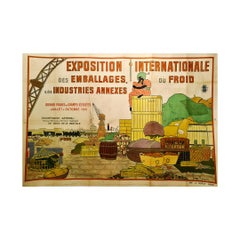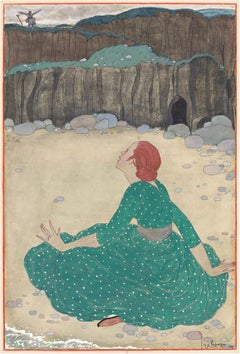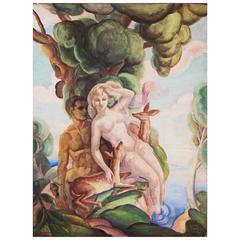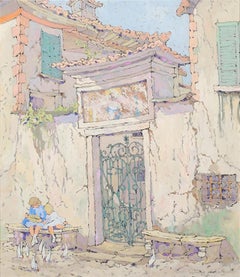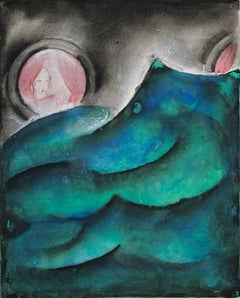Georges Lepape Art
to
4
3
7
5
2
1
1
1
Art Deco Costume Design - Eva
By Georges Lepape
Located in Miami, FL
The paper in some of these photos looks overly textured due to the sharpness of the high-res digital camera.
In person, with the human eye, the paper looks reasonably smooth with out blemishes.
For this fashion illustration, Georges Lepape paints a stunning abstract pattern for the subject dress that is repeated in her hair. The work represents an early use of metallic paint, with silver metallic in the dress and bronze metallic in the blouse. Lepape's highly detailed drawing becomes more evident the closer you look. It's quite amazing how deftly he rendered facial feature on such a small scale. "Eva" 1918 Gouache, watercolor, and ink on paper Signed and dated, lower right: '1918' Inscribed, verso: "Costume for L'enfantement du mort, (miracle en pourpre, et or.). Devised by Marcel L'Herbier and performed at the Théatre Edouard VII and the Comédie des Champs-Elysées, 1919" Provenance: Ex-collection Lucien...
Category
1910s Art Deco Georges Lepape Art
Materials
Ink, Gouache, Paper, Watercolor, Pencil
Art Deco, Woman with a Rose - Original etching
By Georges Lepape
Located in Paris, FR
Georges LEPAPE
Art Deco, Woman with a Rose
Original etching and stencil
Printed signature in the plate
On vellum 16 x 22 cm (c. 6.5 x 9 in)
Excellent condition
Category
Early 20th Century Art Deco Georges Lepape Art
Materials
Etching
A pair of 1913 Hand coloured ponchoir, Art Deco, prints by Georges Lepape (2)
By Georges Lepape
Located in Petworth, West Sussex
Georges Lepape (French, 1887-1971)
Des Ombrelles; and Il Fait Trop Chaud
Hand coloured pochoir prints
1913
8.1/8 x 6 in. (20.8 x 15.2 cm.); and 6.5/8 x 5.1/2 in. (16.8 x 13.8 cm.)
Category
20th Century Art Deco Georges Lepape Art
Materials
Paper
Poster for the International Exhibition of cold packaging and related industries
By Georges Lepape
Located in PARIS, FR
Very beautiful poster for the International Exhibition of cold packaging and related industries made by Georges Lepape 🇫🇷 (1887-1971) in 1913. Georges Lepape was a French fashion d...
Category
1930s Georges Lepape Art
Materials
Linen, Paper, Lithograph
Art Nouveau Woman on Beach in Green Dress Romantic Story "Le Retour"
By Georges Lepape
Located in Miami, FL
In this painting, Art Nouveau French illustrator Georges Lepape depicts a high moment of personal drama. He exquisitely renders a beautiful yet solitary woman sitting on the beach...
Category
1910s Art Nouveau Georges Lepape Art
Materials
Silver
"Nudes by the Sea, " Superb, Classic Art Deco Painting by George Lepape
By Georges Lepape
Located in Philadelphia, PA
This superb and Classic example of Art Deco painting -- with a nude male and female couple attended by two deer at the edge of the sea -- was painted by George Lepape, an important i...
Category
1920s French Art Deco Vintage Georges Lepape Art
Paul Poiret Mobile of Painted and Lacquered Tole 1913
By Georges Lepape
Located in New York, NY
A perfect mixture of fashion and the decorative arts. An image by Georges Lepape originally for the Gazette du Bon Ton,September 1913 forms this amusing metal mobile in a collaborati...
Category
Early 20th Century French Art Deco Georges Lepape Art
Related Items
1910's Art Deco Erte Gouache Painting Original Hand Signed Rare French Costume
By Erté
Located in Buffalo, NY
A rare original signed Art Deco gouache on paper by Erte (Romain de Tirtoff)
.
This stunning theatrical costume design is signed Erte at the lower right.
The piece is 20 by 18 fram...
Category
1910s Art Deco Georges Lepape Art
Materials
Pencil, Archival Paper, Gouache
The Gateway
By Eleanor Parke Custis
Located in New York, NY
Signed (lower right): ELEANOR PARKE CUSTIS
Category
20th Century American Realist Georges Lepape Art
Materials
Paper, Gouache
The Abduction of the Sabine Women , a Renaissance drawing by Biagio Pupini
Located in PARIS, FR
This vigorous drawing has long been attributed to Polidoro da Caravaggio: The Abduction of the Sabine Women is one of the scenes that Polidoro depicted between 1525 and 1527 on the façade of the Milesi Palazzo in Rome. However, the proximity to another drawing inspired by this same façade, kept at the Ecole des Beaux-Arts, and to other drawings inspired by Polidoro kept at the Musée du Louvre, leads us to propose an attribution to Biagio Pupini, a Bolognese artist whose life remains barely known, despite the abundant number of drawings attributed to him.
1. Biagio Pupini, a Bolognese artist in the light of the Roman Renaissance
The early life of Biagio Pupini, an important figure of the first half of the Cinquecento in Bologna - Vasari mentions him several times - is still poorly known. Neither his date of birth (probably around 1490-1495) nor his training are known. He is said to have been a pupil of Francesco Francia (1450 - 1517) and his name appears for the first time in 1511 in a contract with the painter Bagnacavallo (c. 1484 - 1542) for the frescoes of a church in Faenza. He then collaborated with Girolamo da Carpi, at San Michele in Bosco and at the villa of Belriguardo.
He must have gone to Rome for the first time with Bagnacavallo between 1511 and 1519. There he discovered the art of Raphael, with whom he might have worked, and that of Polidoro da Caravaggio. This first visit, and those that followed, were the occasion for an intense study of ancient and modern art, as illustrated by his abundant graphic production.
Polidoro da Caravaggio had a particular influence on the technique adopted by Pupini. Executed on coloured paper, his drawings generally combine pen, brown ink and wash with abundant highlights of white gouache, as in the drawing presented here.
2. The Abduction of the Sabine Women
Our drawing is an adaptation of a fresco painted between 1525 and 1527 by Polidoro da Caravaggio on the façade of the Milesi Palace in Rome. These painted façades were very famous from the moment they were painted and inspired many artists during their stay in Rome. These frescoes are now very deteriorated and difficult to see, as the palace is in a rather narrow street.
The episode of the abduction of the Sabine women (which appears in the centre of the photo above) is a historical theme that goes back to the origins of Rome and is recounted both by Titus Livius (Ab Urbe condita I,13), by Ovid (Fasti III, 199-228) and by Plutarch (II, Romulus 14-19). After killing his twin brother Romus, Romulus populates the city of Rome by opening it up to refugees and brigands and finds himself with an excess of men. Because of their reputation, none of the inhabitants of the neighbouring cities want to give them their daughters in marriage. The Romans then decide to invite their Sabine neighbours to a great feast during which they slaughter the Sabines and kidnap their daughters.
The engraving made by Giovanni Battista Gallestruzzi (1618 - 1677) around 1656-1658 gives us a good understanding of the Polidoro fresco, allowing us to see how Biagio Pupini reworked the scene to extract this dynamic group.
With a remarkable economy of means, Biagio Pupini takes over the left-hand side of the fresco and depicts in a very dense space two main groups, each consisting of a Roman and a Sabine, completed by a group of three soldiers in the background (which seems to differ quite significantly from Polidoro's composition).
The balance of the drawing is based on a very strongly structured composition. The drawing is organised around a median vertical axis, which runs along both the elbow of the kidnapped Sabine on the left and the foot of her captor, and the two main diagonals, reinforced by four secondary diagonals. This diamond-shaped structure creates an extremely dynamic space, in which centripetal movements (the legs of the Sabine on the right, the arm of the soldier on the back at the top right) and centrifugal movements (the arm of the kidnapper on the left and the legs of the Sabine he is carrying away, the arm of the Sabine on the right) oppose each other, giving the drawing the appearance of a whirlpool around a central point of support situated slightly to the left of the navel of the kidnapper on the right.
3. Polidoro da Caravaggio, and the decorations of Roman palaces
Polidoro da Caravaggio was a paradoxical artist who entered Raphael's (1483 - 1520) workshop at a very young age, when he oversaw the Lodges in the Vatican. Most of his Roman work, which was the peak of his career, has disappeared, as he specialised in facade painting, and yet these paintings, which are eminently visible in urban spaces, have influenced generations of artists who copied them abundantly during their visits to Rome.
Polidoro Caldara was born in Caravaggio around 1495-1500 (the birthplace of Michelangelo Merisi, known as Caravaggio, who was born there in 1571), some forty kilometres east of Milan. According to Vasari, he arrived as a mason on the Vatican's construction site and joined Raphael's workshop around 1517 (at the age of eighteen according to Vasari). This integration would have allowed Polidoro to work not only on the frescoes of the Lodges, but also on some of the frescoes of the Chambers, as well as on the flat of Cardinal Bibiena in the Vatican.
After Raphael's death in 1520, Polidoro worked first with Perin del Vaga before joining forces with Maturino of Florence (1490 - 1528), whom he had also known in Raphael's workshop. Together they specialised in the painting of palace façades. They were to produce some forty façades decorated with grisaille paintings imitating antique bas-reliefs.
The Sack of Rome in 1527, during which his friend Maturino was killed, led Polidoro to flee first to Naples (where he had already stayed in 1523), then to Messina. It was while he was preparing his return to the peninsula that he was murdered by one of his assistants, Tonno Calabrese, in 1543.
In his Vite, Vasari celebrated Polidoro as the greatest façade decorator of his time, noting that "there is no flat, palace, garden or villa in Rome that does not contain a work by Polidoro". Polidoro's facade decorations, most of which have disappeared as they were displayed in the open air, constitute the most important lost chapter of Roman art of the Cinquecento. The few surviving drawings of the painter can, however, give an idea of the original appearance of his murals and show that he was an artist of remarkable and highly original genius.
4. The façade of the Milesi Palace
Giovanni Antonio Milesi, who commissioned this palace, located not far from the Tiber, north of Piazza Navona, was a native of the Bergamo area, like Polidoro, with whom he maintained close friendly ties. Executed in the last years before the Sack of Rome, around 1526-1527, the decoration of Palazzo Milesi is considered Polidoro's greatest decorative success.
An engraving by Ernesto Maccari made at the end of the nineteenth century allows us to understand the general balance of this façade, which was still well preserved at the time. The frescoes were not entirely monochrome, but alternated elements in chiaroscuro simulating marble bas-reliefs and those in ochre simulating bronze and gold vases...
Category
16th Century Old Masters Georges Lepape Art
Materials
Ink, Gouache, Pen
CASANOVA
By Louis Icart
Located in Aventura, FL
Etching on paper. Hand signed lower right margin. Image size: 20 x 13 inches. Frame size approx 36 x 27 inches.
Reference: Figure 331 page 156 in "Louis Icart: The complete etchin...
Category
1920s Art Deco Georges Lepape Art
Materials
Etching, Paper
Chanel No. 5 (suite of four (4) separate prints with varnish on linen backing)
By Andy Warhol
Located in New York, NY
After Andy Warhol
Chanel No. 5 (Suite of Four Individual (Separate) Prints on Linen Canvas), 1996
Suite of Four (4) Separate Individual Limited Edition Offset lithographs in colors o...
Category
1990s Pop Art Georges Lepape Art
Materials
Offset, Lithograph, Linen, Digital, Digital Pigment
Sling-Shots Lit #3
By Robert Rauschenberg
Located in Washington Depot,, CT
lithograph & screenprint on paper & assemblage with Sailcloth, Mylar, Wooden lightbox, fluorescent fixture, aluminum moveable window shade system and Plexiglas
Ed. 23/25
Category
1980s Abstract Expressionist Georges Lepape Art
Materials
Mylar, Plexiglass, Wood, Paper, Sailcloth, Lights, Lithograph, Screen
Art Deco French signed Lithograph manner of Icart
Located in FR
Art Deco signed Lithograph from the Louis Icart era of 'Les Elegantes'
Signed in pencil by the artist and Numbered 22
Original print produced for the ar...
Category
1920s Art Deco Georges Lepape Art
Materials
Aquatint, Lithograph
Art Deco French signed Lithograph style of Icart
Located in FR
Art Deco signed Print from the Louis Icart era of 'Les Elegantes'
Signed in pencil by the artist and Numbered 67
Original print produced for the artist ...
Category
1920s Art Deco Georges Lepape Art
Materials
Engraving, Aquatint, Lithograph
(Fred Astaire) Judy Garland and Ann Miller in "Easter Parade", Figurative Litho
By Virginia Fisher
Located in Soquel, CA
Fred Astaire: Judy Garland and Ann Miller in "Easter Parade" black dress by Virginia Garland (American). Signed “Virginia Fisher AP” in pencil lower ri...
Category
1940s Art Deco Georges Lepape Art
Materials
Glitter, Lithograph, Paper
H 24 in W 18 in D 0.003 in
1840 rare watercolor, Native American encampment, Western Indian Unknown artist
Located in Buffalo, NY
A rare mid 19th Century watercolor depicting Native Americans approaching a fort.
The subjects appear to be from a Northern Plains Tribes, and arre approaching a palisades style f...
Category
1840s American Realist Georges Lepape Art
Materials
Paper, Gouache, Watercolor
1960 Young Naked Woman Painting Signed Hilgers Olympia Nude Art Deco
By A. David
Located in Marseille, FR
Oil painting on canvas signed Hilgers in the lower right, from the 1930s, representing a young woman sort of naked Olympia in the Art Deco style. Canvas size 100 x 50 cm and frame di...
Category
1930s Art Deco Vintage Georges Lepape Art
Materials
Canvas
Jo Haran, Tropical Haven, Original floral painting
By Jo Haran
Located in Deddington, GB
Tropical Haven by Jo Haran [2021]
original
Watercolour, gouache and gesso
Image size: H:49 cm x W:66 cm
Complete Size of Unframed Work: H:52.5 cm x W:69.5 ...
Category
21st Century and Contemporary Contemporary Georges Lepape Art
Materials
Gesso, Watercolor, Gouache
Previously Available Items
Art Deco, Woman with a Rose - Original etching
By Georges Lepape
Located in Paris, FR
Georges LEPAPE
Art Deco, Woman with a Rose
Original etching and stencil
Printed signature in the plate
On vellum 16 x 22 cm (c. 6.5 x 9 in)
Excellent condition
Category
Early 20th Century Art Deco Georges Lepape Art
Materials
Etching
Untitled Watercolor
By Georges Lepape
Located in Wilton, CT
Watercolor/ Gouache by LePape showing portholes on an ocean liner and vibrantly colored waves.
Category
1920s Art Deco Georges Lepape Art
Materials
Gouache
Costumes de Théâtre, Ballets et Divertissements
By Georges Lepape
Located in Wilton, CT
Georges Lepape's designs for stage sets and costumes of Rip's ballet-pantomime ‘Le Coup Manqué’ and Marcel L'Herbier's play ‘L'Enfantement du Mort.’ Includes a four-page preface by H...
Category
1920s Art Deco Georges Lepape Art
Materials
Other Medium
Permissionaire - Original Gouache by Georges Lepape - 1919
By Georges Lepape
Located in Roma, IT
Permissionaire is an original, rare modern artwork realized by Georges Lepape in 1919.
Original pochoir. Passepartout included (cm 35.5 x 26.5). A wood frame is included (cm 40.5 x ...
Category
1910s Art Deco Georges Lepape Art
Materials
Color
H 7.88 in W 5.12 in D 0.04 in
Le Manteau Rouge, Original Gouache
By Georges Lepape
Located in Roma, IT
Le Manteau Rouge is an original modern artwork realized by Georges Lepape in the 1920s.
Original gouache. Passepartout included (cm 63 x 49). A wood ...
Category
1920s Art Deco Georges Lepape Art
Materials
Gouache
Le Ballon - Original Mixed Media by Lepape
By Georges Lepape
Located in Roma, IT
Le Ballon is a wonderful colorful drawing (watercolor, gouache, charcoal drawing) on paper realized by the French illustrator Georges Lepape. This artwork, representing two young lad...
Category
Early 20th Century Art Nouveau Georges Lepape Art
Materials
Charcoal, Watercolor, Gouache
H 13.78 in W 11.42 in D 0.04 in
Georges Lepape art for sale on 1stDibs.
Find a wide variety of authentic Georges Lepape art available for sale on 1stDibs. You can also browse by medium to find art by Georges Lepape in paper, gouache, paint and more. Much of the original work by this artist or collective was created during the 20th century and is mostly associated with the Art Deco style. Not every interior allows for large Georges Lepape art, so small editions measuring 5 inches across are available. Customers who are interested in this artist might also find the work of Umberto Brunelleschi, Mabel Allington Royds, and W. Smithson Broadhead. Georges Lepape art prices can differ depending upon medium, time period and other attributes. On 1stDibs, the price for these items starts at $277 and tops out at $38,000, while the average work can sell for $1,780.


